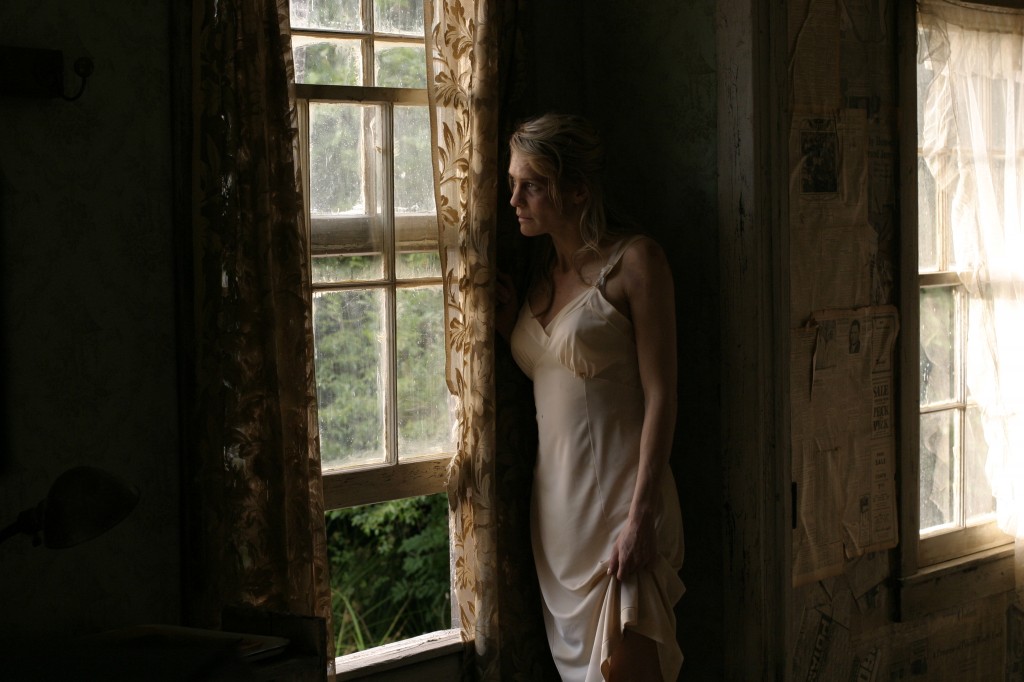Deborah Kampmeier on Hounddog’s Themes
(i) darkness into light
(ii) motherlessness
(iii) the cycle of abuse
(iv) silencing
(v) female sexuality
(vi) fecundity of the feminine
(vii) snake medicine
(viii) raw poetry
(ix) music
“Focusing on the themes of the film was very useful when working with my creative team. With my directors of photography Ed Lachman and Jim Denault, my production designer Tim Grimes, my costume designer Leigh Leverett, my editors Sabine Hoffman and Andrew Marcus, my sound designers Tom Paul and Paul Hsu and my composer Gisburg Smialek. It was a way of powerfully focusing our vision.”
(i) darkness into light
“One of the ideas in the story is about bringing what’ s in darkness into light. Charles questions Lewellen,’ What’ s hiding in the dark?’ Bringing light and consciousness to our wounds is an act of healing. It’s sometimes scary to do that, and oftentimes painful to do that, but once you’ve done it the healing can begin.
I think there is a societal terror around bringing consciousness to the secret of sexual abuse of children, which remains an epidemic in our society. It’ s like when you have a secret and you feel like you will die if you tell it. As a society we feel like we will die if we tell this. But once you’ve told it, it’ s not so bad any more. It’ s no longer the enormous burden it was. And now there’ s a small opening for light to move in and for transformation to occur.
Ed and I spoke a lot about the shadows and the light. In the beginning Lewellen is the light that is constantly moving into the darkness.
Darkness is also a place of healing and transformation, a place of gestation. ‘If your dreams gotta go underground for a while, bury themselves deep in the earth,’ Charles says, ‘you’ll keep feeling the spirit, keep feeling the spirit, even in the dark.’ There is hope, even in the darkness. The light is only found by going thru the darkness and out the other side.”
(ii) motherlessness
“Every character in the film is motherless, except for Charles, and he is the one nurturing force in the film, the one character who is able to mother. Every other character is motherless in their own way. Grammie, Daddy, Stranger Lady, Lewellen. They are all longing for mother. It is the emptiness they feel and try to fill, each in their own way, Grammie with the bible, Daddy at first with alcohol and violence, then after the accident with Lewellen, Stranger Lady with sex and abusive men, and Lewellen with Elvis.
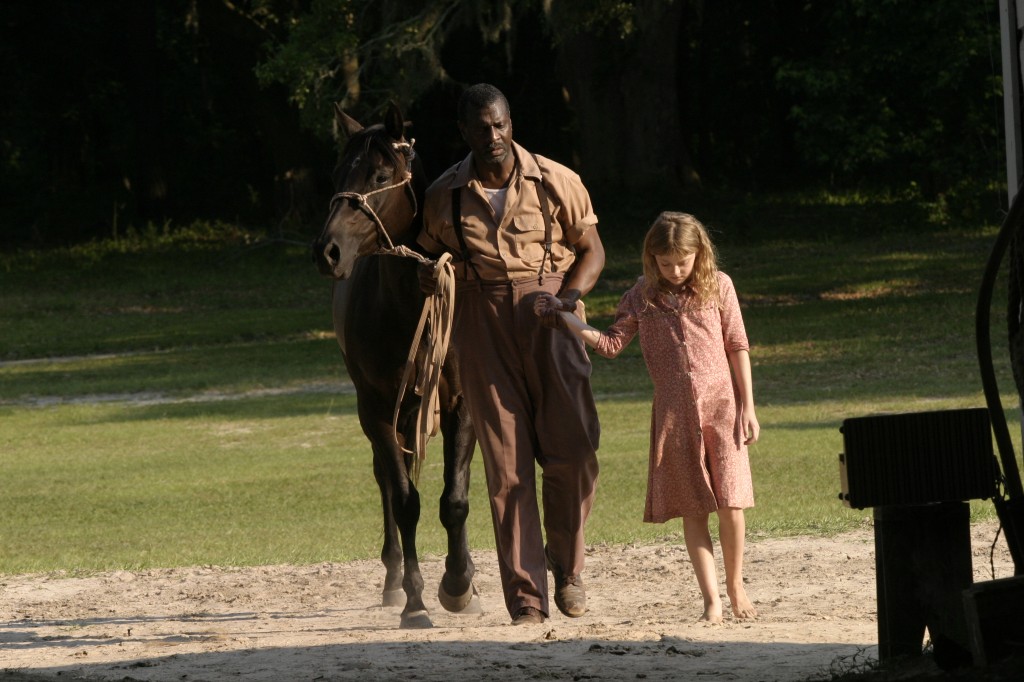
Afemo Omilami and Dakota Fanning in Hounddog
We often wrongly blame mothers for the wounds of their children, but they themselves are simply wounded children as well. We are living in a society that wounds our daughters, and they in turn grow up to wound their daughters, and the cycle never ends. Our daughters and our earth are raped and silenced over and over again.
Charles says, ‘maybe you’ll finally be putting your arms on round yourself the way your mama never could.’ Maybe we all need to find a way to put our arms around ourselves the way our mama’ s never could.”
(iii) the cycle of abuse
“I see every character in this film as a wounded soul. There are no evil characters, only wounded ones. After Lewellen is assaulted, she herself begins down a path of destruction, first self-destruction and then one of hurting others, striking out, abusing others. As Charles says, ‘you have to fill all those empty hollow places, you have to fill them or they turn mean and eat you alive.’ The cycle of abuse has to be stopped within oneself. At a certain point we have a choice, to drown in our shit, or take our shit and turn it into gold. Hopefully we have the support around us to choose the latter. It’s what artists often have the opportunity to do. It’s what music gives Lewellen the opportunity to do.”
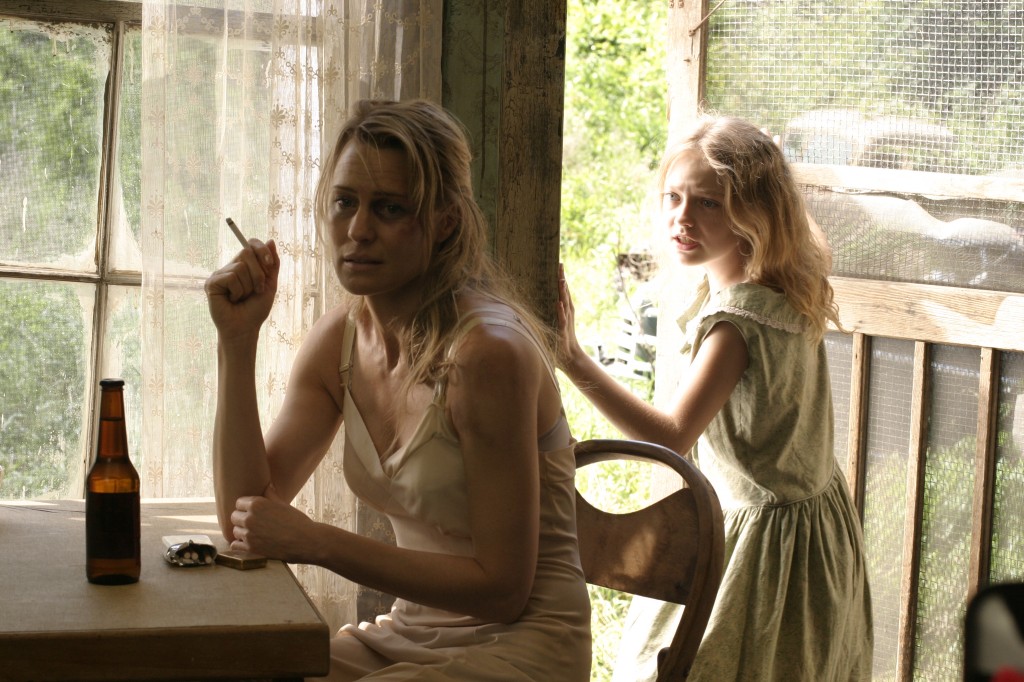
Robin Wright and Dakota Fanning in Hounddog
(iv) silencing
“I started out making Hounddog to tell a story. A story actually about a girl whose voice and spirit are silenced, and a story about this girl’ s reclaiming of her voice on a deeper and truer level, a reclaiming of her spirit and of her power. I started out making this film on a very personal level. I’m not a political filmmaker. I just want to make my little films that mean a lot to me. But in the 12 year struggle to get this story told it became impossible not to address the politics of being a woman filmmaker and the telling of women’ s stories. The silencing of this story has been astonishing and the silencing of women’ s voices, in general, disturbing.
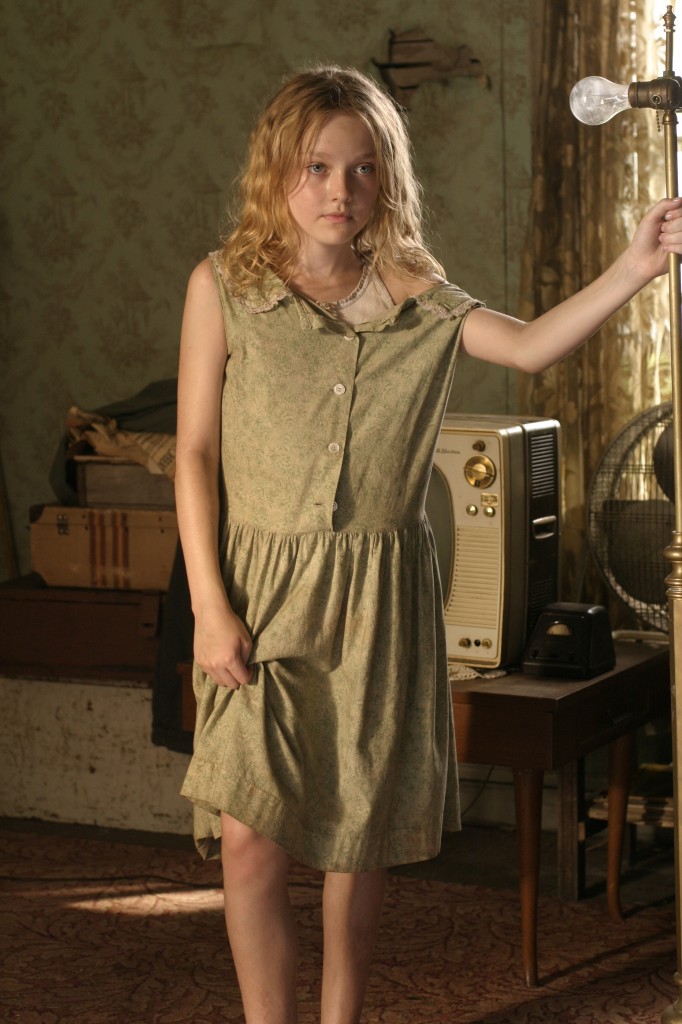
Dakota Fanning in Hounddog
Only 6% of films are directed by women. This is a troubling fact. Film is the primary form of storytelling in our current society and the fact that 94% of those stories are told by men reveals a deep, chronic and disturbing imbalance. I feel there’ s a great need for not only this story, but women’ s stories in general to be told. I think that the health of our earth depends on our stories as women being told, our voices being heard.”
(v) female sexuality
“We live in a paradigm that doesn’t nurture, nourish and develop women’s sexuality. That doesn’ t honor it for the beautiful, powerful, awe-inspiring gift that it is. Instead, it is something that is exploited, commercialized, repressed, shamed and abused.
Why is a young girl, like Lewellen, in the blossoming of her body, her spirit and her sexuality seen as “asking for it” when she is simply and innocently experiencing and relishing the aliveness of her being, the life force pulsing through her body, celebrating the power and creative force of her sexuality that is her birthright?

Dakota Fanning and Cody Hanford in Hounddog
Why do we keep our girls naïve about their sexuality? Why don’t we help our sisters and our daughters to know their sexuality for themselves so they feel their own power and can share it when and with whom they choose?
When you cut a woman or girl off from her sexuality, you rob her of a huge chunk of her soul.”
vi) fecundity of the feminine
“I wanted to continue bringing the feminine into focus…into consciousness. Nature represents in the film that force that just keeps coming – the abundance of its fertility, its creativity. It overcomes, it devours death, it overwhelms the hollow, empty, useless cars, it begins to devour Daddy’ s shack.
Grammie keeps it cut back. She wants it in order. She puts it in jars on her shelves. Keeps it neat and contained inside her white picket fence. She is the force trying to stop it, repress it. It frightens her.
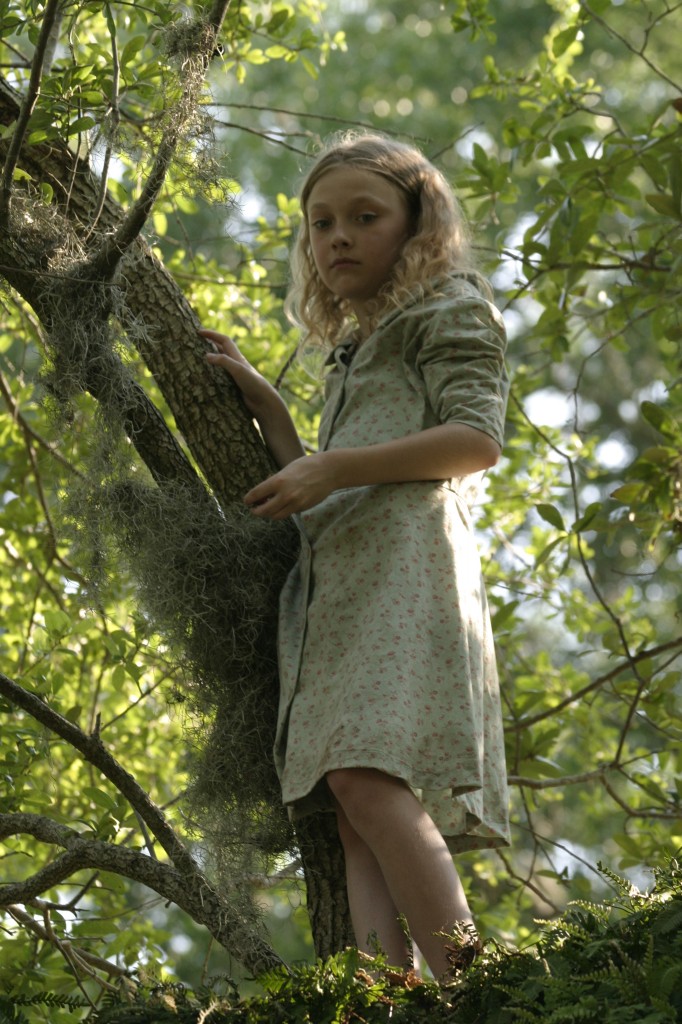
Dakota Fanning in Hounddog
I had this idea I wanted to start every moment of Lewellen with nature if possible. It wasn’t possible. But that idea of her life force, bursting into the emptiness. The exuberance of nature and the exuberance of youth and Lewellen’ s experience intertwined.
I wanted to use the camera to capture the feminine force… the fecundity underneath everything. The life force of the feminine that maybe has to go underground for a while to protect itself but is going to explode any moment.”
(vii) snake medicine
“The church has done to snakes what it has done to female sexuality. It has made them evil and dangerous. But in other cultures and religions, ones that are earth-based and female-based, the snake has held a different meaning and power. Snake is considered the most sacred of animals. The life giver. Women sprang from the snake. The snake is the goddess of fertility and life force. The snake is the goddess of wisdom. Snake is the sacred female sexuality. The most sacred of all energies.
As the character Charles says, ‘Snake medicine people are rare. Their initiation comes from getting and living through many, many snake bites making them able to change all poisons. Poison in the body, poison in the mind, poison in the heart or poison in the soul. They turn those bites from poison which can kill you into something powerful and good. They learn that all things are the same. And the things you think are poison can go through you and be changed if you have the proper state of mind about it.’
It’ s the lesson of the film, that you have to take those things that can poison you and turn them into something powerful and good…which is ultimately what Lewellen does.”
(viii) raw poetry
“I talked to all of my creative collaborators about my desire to find the pull, as tautly as I could, between the raw realness of the film and the poetry of it. I wanted to find the balance between the two extremes. And the tension between the two extremes. How far could I pull one way without breaking the other. And visa versa. The clichés of “Southern Gothic” come from a mysterious truth found in the South that there is something mythic in the dysfunctions of this world. And something beautiful in our desires to wrestle them…”
(ix) music
Lewellen is a very precocious free spirit romping through the wilderness. She lives in an environment that could crush her spirit. But she’ s found music and she’ s found Elvis. Music is the place she can go to express all of the pain and the rage in her life, as well as the joy and love. Music is her safe haven to express herself. Along her journey there are a lot of twists and turns that lead her eventually to really find her true voice instead of Elvis’ voice. In the end, it’ s her own voice that Lewellen connects to. And with that connection to her true voice she is able to turn and walk away from this world that can harm her.
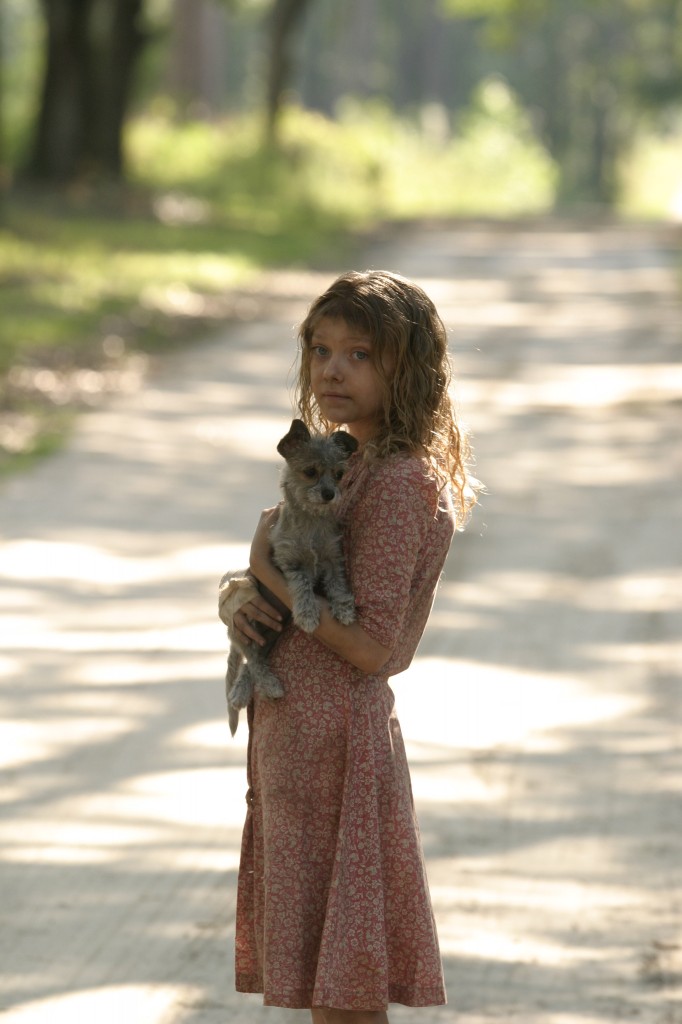
Dakota Fanning in Hounddog

